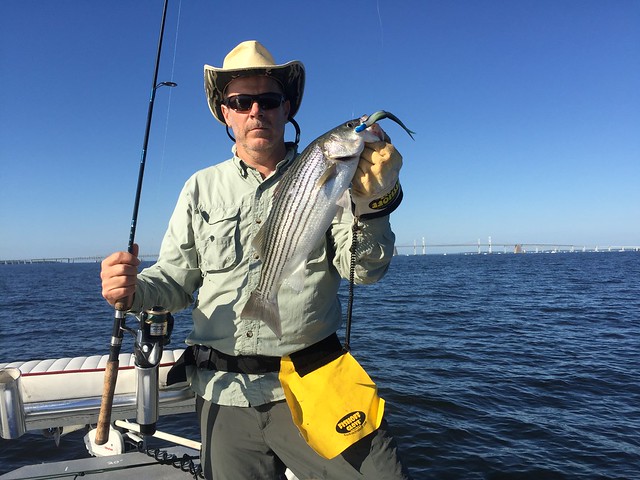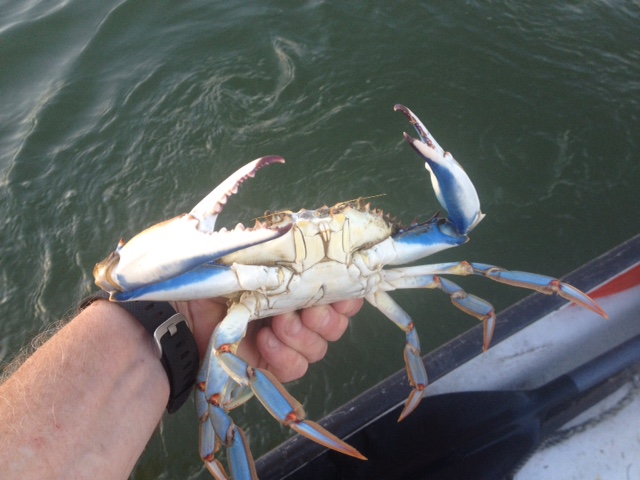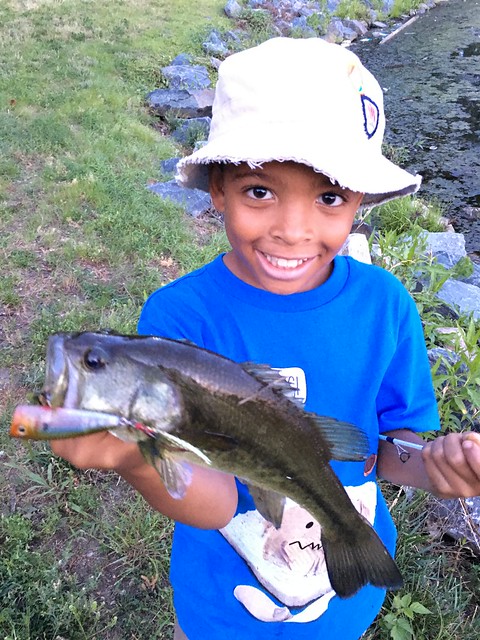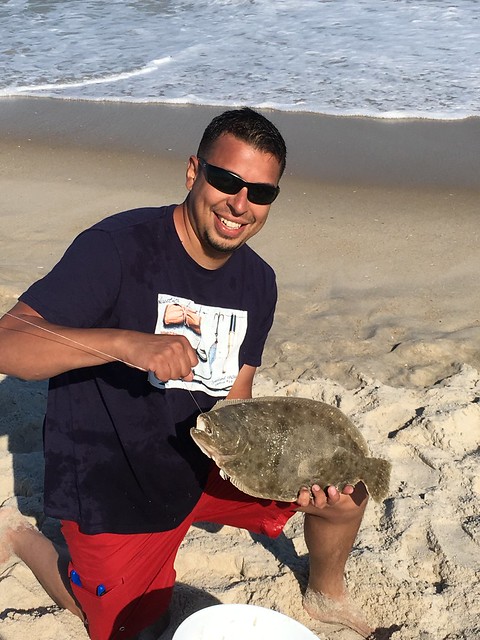By: Keith Lockwood
Blink your eyes, and here we are facing the Fourth of July weekend. It is a time for family and friends and many will be out on the water fishing and crabbing or spending time freshwater fishing near a cool and friendly pond or stream. July 4th is a Free Fishing Day and it is a great opportunity to take a friend or neighbor with you to perhaps introduce them to fishing or to remind a lapsed angler how much fun they are missing.
The Conowingo Dam continues to release water for power generation in the early afternoons but before that there is hardly any water coming out of the dam. There is a limited early morning striped bass bite in the calm dam pool for those casting topwater lures, suspended jerkbaits or flipping out live eels or white perch. Out along the channel edges near the flats and the mouth of the river there is an early morning topwater striped bass bite that is diminishing with rising water temperatures this week.
A large percentage of the resident striped bass from the lower and middle bay regions have moved into the upper bay region in the past couple of weeks. They can be found spread out along the shipping channel edges near Sandy Point Light, the mouth of the Magothy River and the Love Point channel edges. This is a happy time for boat crews coming out of upper bay ports. Chumming and chunking tends to be the most popular way of fishing and the armada of boats anchored up in these areas can be daunting. At times this can seem like combat fishing as boats and captains jockey for the best position and as the fleet swings with changing tides it can get very interesting at times. I would remind all that you're supposed to be out there to have a good time and if the heat is too much in the kitchen get out and find your own little piece of space somewhere else. Charter boat captains have to put their patrons on fish so they are going to do what it takes and they will put up with crowded conditions. If one watches their depth finder and explores channel edges in other areas striped bass can be found holding and you can set up on them with chum or chunks. A fair portion of the striped bass being encountered are sub-legal, so care must be taken to ensure they survive catch and release. Please use and encourage others to use circle hooks to minimize deep hooking injuries which are usually fatal within a few hours when using J-style hooks.
For those who wish to skip the mess of ground up menhaden, jigging over a suspended school of fish can be a lot of fun on light tackle. Soft plastic jigs such as BKDs or Bass Assassins have been favorite jigs to use. Trolling can also be effective and one can cover a lot of territory in their search for fish, just be careful to stay away from the chumming fleet. Umbrella rigs behind inline weights with swim shads or bucktails for trailers have been hard to beat. Small spoons behind planers are a close second and tend to be easier to reel in. A few of the alternative locations worth looking over are the mouth of Baltimore Harbor, the Triple Buoys, Swan Point and the Hart-Miller Island area. If all else fails, the Bay Bridge piers always seem to hold fish. This happy group of friends caught these nice fish north of the Bay Bridge in about 30' of water while jigging.

Photo courtesy of Jay Bernstein
The white perch fishing in the upper bay has been good to excellent in many of the tidal rivers and bay shorelines as well as shoal areas such as the 7' and 9' Knolls and Man O War Shoals. Bloodworms or Fishbites on a bottom rig are standard fare when fishing some of the deeper areas. Casting to shoreline structure with small jigs, spinners and beetle-spins on ultra-light tackle offers a lot of fun in the mornings and evenings. A good high tide either ebbing or flooding usually offers the best opportunities and the same holds when casting topwater lures for striped bass.
We all followed the outrageous and massive striped bass poaching case that occurred off of Kent Island in 2011 that started an extensive investigation by the Natural Resources Police. A recent Department of Natural Resources press release helps outline what the final outcome is for those involved.
In the middle bay region striped bass are spread throughout the region. They can be found along the shipping channel edges along the western and eastern sides of the bay. The concentrations of fish are not what they were several weeks ago but there are fish out there if one does some exploring. Trolling umbrella rigs behind inline weights or spoons behind planers is a good way to get down to where the fish are suspended near 35' to 40' edges. Watching a depth finder will help to locate schools of fish and at times light tackle jigging can be a fun alternative. There is a mix of sizes in the schools, and a fair percentage will fall a few inches short of the 20" minimum. Bass Assassins and similar soft plastic jigs have been the most popular jigs to use lately. Eastern Bay should not be overlooked; there are some good steep edges on the Tilghman Island side as well as Kent Island. The Kent Narrows always offers shore bound anglers a good chance to score on a nice striped bass or two and the area always holds a lot of white perch. The lower sections of the region's tidal rivers have been offering some good jigging action along channel edges, especially in the early morning and evening hours. James Berry holds up a nice one he caught while jigging.

Photo by Travis Long
Chumming at Hacketts and off Poplar Island at the Hill and Clay Banks is still in play although recent reports are not as good as they were a couple of weeks ago. Charter boats from the mid-bay area have been making the trek to above the Bay Bridge. Water temperatures in the middle bay region are in the upper 70's this week and salinities are slightly down.
The shallow water striped bass action has been a great way to catch striped bass this week; water temperatures are still cool enough to keep this fishery very active. Topwater lures are perhaps the best choice when fishing over grassy areas but swim shads and suspended jerkbaits are also good choices when casting in deeper areas near structure such as breakwaters and rocks. This is an early morning or evening window of fishing and a very pleasant way to spend time out on the water. White perch will also be found in the same areas so an ultra-light spinning matched up with a beetle-spin or spinner offers some extra fun.
The lower bay region is offering some exciting fishing this week for several species of fish that are not being seen farther up the bay. The croaker fishing in the lower Patuxent and Potomac Rivers has been outstanding with limit catches of 10" to 12" croakers the norm. Bloodworms, peeler crab, shrimp or artificial bloodworm baits are being used on simple two hook bottom rigs. White perch will also be part of the mix along with blue catfish in the lower Potomac. There is a bit of croaker action in the Pocomoke/Tangier Sound area but it has been reported to be only fair.
Striped bass are being caught in the lower Potomac and Patuxent River areas and along the eastern side of the bay. Trolling has been popular but jigging has been effective also. Small bluefish are being caught in the Point Lookout area and more and larger bluefish will be filling in soon.
There has been some exciting cobia action near the Middle Grounds and the Target Ship recently and some big ones have been caught. Chumming has been popular and the cobia have been caught on cut bait or live bait drifted back in the chum slick. Casting live bait such as crabs or eels near buoys is also a proven strategy. Large red drum are also being reported above the Target Ship and a few have been caught and released by trolling large spoons behind inline weights.
Recreational crabbing continues to be excellent in the tidal rivers of the middle and lower bay regions this week. Crabbing in the upper bay is showing improvement. It is not uncommon for most to be able to catch a full bushel of good crabs per outing.

Photo by Jim Livingston
You may have heard the news that beginning in October 2015, Maryland recreational fishing and crabbing licenses are now valid for 365 days from the date of purchase.
We are reaching out to those who previously registered waterfront crab pots with these clarifications/reminders:
- The change in recreational licenses (from calendar year to 365 days from date of purchase) also applies to the waterfront crab pot registration.
- If you completed your free registration to use crab pots off private shoreline property prior to October 1, 2015, your registration has expired. Details on how to register are available here: FAQs on Waterfront Property Crab Pot Registration.
- Turtle excluders are required in recreational crab pots in Maryland. These devices prevent terrapins from entering a crab pot without hindering blue crab entry. Without turtle excluders, terrapins can enter crab pots and drown. You can make your own turtle excluder or visit a retail store to purchase one for your pots. When replacing a crab pot, look for one with turtle excluders already installed.
Information from waterfront crab pot registrations continues to provide the Department with improved information on recreational crabbing effort and helps us to raise awareness and assist property owners with information about using turtle saving devices.
As summer progresses freshwater anglers will see most species of fish slipping into a summer mode of behavior where early morning and late evening fishing will offer the best results. At Deep Creek Lake this means getting out on the lake before daybreak and wrapping things up by mid-morning not so much because of the fish but because of boat traffic. There has been good smallmouth bass fishing outside of floating docks and rocky points; tubes have been a favorite bait. There are largemouth bass holding under floating docks and shoreline structure such as fallen tree tops. Casting plastics such as stick worms or similar soft plastics under docks or to cover is a good tactic. The larger northern pike tend to be holding deep now near the mouths of coves and smaller ones along with chain pickerel can be found in the grassy coves. Spinnerbaits can be a good choice when fishing deep for the big ones. There are also some deep fishing opportunities for trout along the dam face while slow trolling deep with nightcrawlers.
The upper Potomac tends to be in good shape this week for smallmouth bass fishing. Clear water tends to make them very cautious so fluorocarbon line in lower poundage helps and being quiet on the water and fishing slow are good tactics. Tubes, small crankbaits and spinnerbaits are good choices for lures.
Earlier this month the Fisheries Service made an announcement concerning a few public access issues at some popular freshwater fishing locations, click here to read the information.
Fishing for largemouth bass as could be expected has slipped into a summer mode of behavior where the bass are seeking cool shade during the heat of the day and venturing into shallow feeding areas in the evenings through the night and into the early morning hours. This is a fun time to break out the topwater lures such as frogs, buzzbaits, chatterbaits and poppers. Targeting grass, lily pads and spatterdock are good choices as well as creek mouths and shallow structure such as fallen tree tops. When largemouth bass are hunkered down in thick grass weedless stick worms or similar soft plastics can be dropped down through the grass. Sunken wood or transition edges leading to shallower waters can be fished with suspended jerkbaits, spinnerbaits, jigs or small crankbaits. This little fellow is certainly happy with this largemouth bass he caught on a popper.

Photo courtesy of George Maddox
The Fisheries Service hatchery program has been busy raising other species of fish besides trout this past spring. To augment natural reproduction, walleye fingerlings obtained from Manning hatchery were stocked into the following areas: Triadelphia Reservoir (Howard, Montgomery Counties) – 20,000; Rocky Gorge Reservoir (Howard, Montgomery, Prince George's Counties) - 20,000; Savage River Reservoir (Garrett County) - 50,000; Liberty Reservoir (Baltimore County) - 50,000. An additional 30,000 walleye fingerlings were stocked in the nontidal Potomac River. These fingerling walleye were marked with oxytetracyline (OTC) to allow biologists to differentiate the stocked fish from wild fish and evaluate the contribution of the stocking program to annual year class strength.
Ocean City area water temperatures are rising into the low 70's this week and the fishing scene is adjusting to one more familiar with summer. Surf fishermen are catching a mix of kingfish, flounder and blowfish in the surf when using small baits such as bloodworms or squid. Those using finger mullet are catching small to medium-sized bluefish and dogfish, black drum, sting rays and skates are being caught on larger cut baits. Inshore sharks are beginning to show up in the surf zone in the evenings. Elmer Merino caught this nice flounder in the surf while fishing for kingfish with squid.

Photo courtesy of Elmer Merino
At the inlet some exciting striped bass fishing continues for anglers casting bucktails, swim shads and bluefish are also being caught mostly on Got-Cha plugs. A few tautog and sheepshead are being caught on sand fleas near the South Jetty and nearby bulkheads and bridge piers. Flounder are moving through the inlet and can be caught on white Gulp baits or traditional minnow or squid bait.
In the back bay areas flounder are being caught in the channels and channel edges from Sinepuxent Bay to the Route 90 Bridge. Drifting with white Gulp lures or minnow and squid baits are popular. Small sea bass, blowfish and sea robins have been enjoying the squid baits and help cut the slow times between flounder bites.
Outside the inlet sea bass catches have been fair to good at the wreck and reef sites and flounder are quickly becoming part of the mix. Farther offshore at the canyons there are a lot of small yellowfin tuna in the area of the Poorman's Canyon down to the Washington Canyon. Gaffer size dolphin, bigeye tuna and white marlin are also part of the mix.
Boom...Morgan
nice post
ReplyDelete